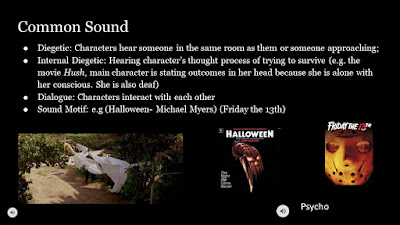I found the title sequence for this film, Split, on the website Art of the Title. The genre for this film is under the Thriller category. The film seems to have already briefly started. Before the titles appear, a clip plays of a man wearing a mask and glasses, holding a spray bottle reaches his arm towards the camera inside of a car. In total, there were 22 titles, with the first one being the name of the production company, Universal Studios. The titles are presented on a simple black background with white text. When transitioning to a new title, a 4x6 grid of the next title appears flashing, which then all goes black and reveals the next title. The first three all include the production companies and the creator of the film. The following title is simply the name of the movie: Split. In between some of the titles are little clips of a hallway of some sort, in which the camera slowly pans down revealing a woman being transported on a cart through it. The rest of the titles display some of the actors' names and the production team (e.g. Music Producer, Executive Producer, etc.). The final title is simply the text saying "Written and Directed by M. Night Shyamalan."
The images shown throughout the title sequence carry the connotation that the movie is mysterious and ominous. The woman being transported through the hallways unconsciously on a cart is not something that typically is a daily occurrence for most. This gives the audience a sense that something bad is about to happen, and encourages them to continue watching. The text used in the title sequence is connected when on top of each other. For example, the letter "Y and L" would be connected through the bottom of the Y and top of the L. This reinforces the name and genre of the movie "Split" which is ironic since the letters in the titles aren't split. The music is also very eerie, as it has no melody, beat, or lyrics. Simply just background noise, mixed with humming and rumbling. This also reinforces the genre as the music can give the audience a thrilling experience.
The film establishes an enigma from the beginning by cutting in the middle of the scene of the man with the mask. The man is clearly up to no good, and by cutting right as the audience is about to see what occurs, it builds mystery and hype to continue watching. As well as the woman being transported in the hallways. The viewers have no clue what has happened and what might happen later. All of these strategies are also used to ensure that the film appeals to viewers who enjoy Thriller films. Technology has been used effectively by the way that the title sequence is presented. Since it is simply text, the camera plays no part in it. They must use computer software to generate the grids flashing for the transitions, and the connected text, as well as adding the bits and pieces of clips during the sequence. When the camera is being used, the camera angles are from a low angle looking upward. Which with every new clip after each title, it slowly pans downward, which then reaches and reveals the woman on the cart.







































